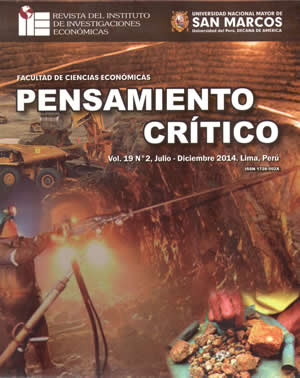Crédito comercial: el caso de la empresas agroindustriales de la economía peruana (1998-2013)
DOI:
https://doi.org/10.15381/pc.v19i2.11106Palabras clave:
Crédito comercial, empresas agroindustrialesResumen
El crédito comercial es una operación de crédito a corto plazo vinculada a un acto comercial mediante el cual el proveedor otorga facilidades a sus clientes por la compra de su producto bajo ciertas condiciones que permitan retrasar el pago.
El crédito comercial juega un papel importante en las empresas agroindustriales donde coexisten medianos y pequeños productores básicamente de caña de azúcar y otros productos complementarios recientes (eje. alcachofa, paprika, uva etc.), que ofertan sus productos a empresas con mayores escalas de producción y transformación de la materia prima en ingenios de propiedad de dichas empresas. Estas empresas con acceso a fuentes financieras y que actúan como canales de intermediación a través de créditos comerciales adelantan sumas de dinero a los productores pequeños y medianos con el compromiso de entregar sus productos.
Estas relaciones desarrollan asimetrías donde el poder de mercado que detentan algunas empresas utilizan el crédito comercial como una fuente importante de financiación para productores con acceso restringido a los mercados de crédito. Las actuales empresas agroindustriales están localizadas en su mayor parte en la costa peruana y son el resultado de la reforma agraria que afectó a las antiguas haciendas, y que se transformaron por la ley N° 17716 en Cooperativas Agrarias de Producción, y posteriormente, conforme a lo normado por el D.L. No. 802 optaron por cambiar el modelo empresarial de cooperativa por el de sociedad anónima.
Descargas
Publicado
Número
Sección
Licencia
Derechos de autor 2014 Gaby Cortez Cortez

Esta obra está bajo una licencia internacional Creative Commons Atribución-NoComercial-CompartirIgual 4.0.
LOS AUTORES RETIENEN SUS DERECHOS:
a. Los autores retienen sus derechos de marca y patente, y tambien sobre cualquier proceso o procedimiento descrito en el artículo.
b. Los autores retienen el derecho de compartir, copiar, distribuir, ejecutar y comunicar públicamente el articulo publicado en la revista Pensamiento Crítico (por ejemplo, colocarlo en un repositorio institucional o publicarlo en un libro), con un reconocimiento de su publicación inicial en la revista Pensamiento Crítico.
c. Los autores retienen el derecho a hacer una posterior publicación de su trabajo, de utilizar el artículo o cualquier parte de aquel (por ejemplo: una compilación de sus trabajos, notas para conferencias, tesis, o para un libro), siempre que indiquen la fuente de publicación (autores del trabajo, revista, volumen, numero y fecha).






